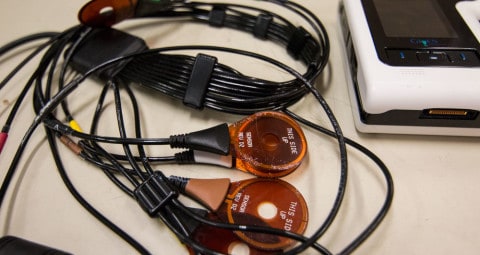University of Saskatchewan veterinary and engineering researchers are adapting endoscopic capsules for use in the veterinary field, providing a new perspective on equine health and diagnostics research — quite literally.
Julia Montgomery, assistant professor and veterinary researcher in the Western College of Veterinary Medicine, took interest in the idea of developing imaging technology for use in equine medicine during a discussion with Khan Wahid, associate professor in the College of Engineering. With the help of Dr. Joe Bracamonte, equine surgeon and associate professor at WVCM, the idea of an equine camera pill came to fruition.
The pill is an endoscopic capsule, with a camera on one end. It transmits a signal to a receiver as it travels through the intestinal tract, capturing images and sending them to one of the eight sensors attached to the animal’s abdomen that track the capsule’s progress and record its data. It is a diagnostic tool that is already being used in humans, and Montgomery and her colleagues are now t esting it in horses as well.
esting it in horses as well.
“The idea came from talking to Dr. Wahid a while back about this imaging technology he had been working on and he mentioned his interest to try it in other species, aside from humans. I immediately thought this might be an exciting technology to try in the horse, both from a diagnostic as well as a research perspective,” Montgomery said in an email to the Sheaf.
Montgomery and Bracamonte took the role of study design and execution, and Wahid provided his expertise on imaging technology. The pill was administered in a pilot study on Mar. 1 and travelled successfully through the horse’s gastrointestinal system over an eight hour period, transmitting a continuous picture of its journey.
Due to the initial study’s success, Montgomery hopes to expand the project and offer opportunities for students to get involved.
“This study was intended as a proof of concept study, to determine if we can easily administer the endoscopy capsule and obtain usable images from the small intestine of the horse,” Montgomery said.
The success of this research could change the methods used by veterinarians to diagnose equine intestinal problems, as well as the way veterinarian students learn about the bowel system. Current procedures used to examine an animal’s small intestine, including exploratory surgery or laparoscopy, are surgically invasive and limited in their diagnostic scope.
“At the moment, we cannot directly assess the small intestine of the horse without surgery. Wired endoscopy can reach the stomach, but not beyond. Due to its size, a horse does not fit into a CT or MRI, aside from the head and the limbs,” Montgomery said.
The camera pill provides a more thorough examination with less health risk to the animal, as it is entirely non-invasive. As many small intestinal problems are often diagnosed indirectly from other diagnostic testing during surgery, the pill would be useful in spotting diseases such as inflammatory bowel disease and cancer, as well as for checking surgical sites or monitoring the effectiveness of administered drugs in the bowel.
In addition to being complementary to the existing imaging technology and other diagnostic tools, the equine endoscopic capsule would also be helpful in answering basic questions about how the standard function of an equine small intestine looks.
“This technology has great potential for use in equine health research. It will help us to study gastrointestinal physiology and pharmacology, for example,” Montgomery said.
While the technology is already in use in human medicine, Montgomery feels that there is a possibility of expansion into other areas of veterinary medicine, such as large breeds of dogs, but the size of the pill does offer some limitations.
As of right now, Montgomery and her colleagues are focusing solely on equine adaptation.
“The plan is to expand the pilot study to include a few more horses this summer and then apply for funding for a larger study in the fall. Ultimately, the goal is to design a system specifically for use in horses.”